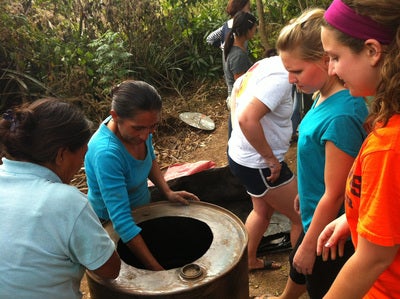 When most students think about studying abroad, they picture themselves sightseeing famous historical landmarks and sampling foreign cuisines. For the U of I students in Global Studies 298, their study abroad was more than a vacation—it was a chance for the students to immerse themselves into the Nicaraguan lifestyle. The students spent two and a half weeks of their winter break working with the community of Sabana Grande, Nicaragua, promoting and producing renewable energy and sustainable practices.
When most students think about studying abroad, they picture themselves sightseeing famous historical landmarks and sampling foreign cuisines. For the U of I students in Global Studies 298, their study abroad was more than a vacation—it was a chance for the students to immerse themselves into the Nicaraguan lifestyle. The students spent two and a half weeks of their winter break working with the community of Sabana Grande, Nicaragua, promoting and producing renewable energy and sustainable practices.
During this two-week adventure, students spent their time learning to make charcoal briquettes by pyrolizing left-over corn husks. The carbonized husks are mashed and mixed with cassava into a paste that is then pressed into forms to produce the briquettes. The students also helped to paint solar ovens, water young fruit trees, gather seeds for new plantings, and even dig a foundation for a new building. This “service learning” enabled the students to fully engage in Nicaraguan life.
“This trip not only allowed us to enhance our knowledge about non-governmental organizations and how they impact globalization, but we were also able to increase our Spanish skills, and engage in activities like making coal and installing solar panels onto a lady’s house so she could receive light in her home for the first time in her life,” says Jessica Newman, one student participant.
After students applied and were accepted into this program, they took a second eight-week course during the fall semester to prepare for their two weeks “in the field” abroad. The course is aimed at teaching students how countries respond to the growth of the world economy in a firsthand way that cannot be fully understood from a classroom. The class was focused on understanding how rural communities like Sabana Grande can develop sustainably by creating a model community centered around renewable energy technologies.
Despite some initial difficulties like differences in the food culture and language barriers, the students were able to observe and immerse in the rural Nicaraguan culture. For the two weeks they were there, the students lived with Nicaraguan families and worked alongside local community members. By the end of the two weeks, the students were no longer outsiders to the Nicaraguan people, they were friends.
“Our appreciation for our lifestyles and different cultures increased, and our passion and knowledge regarding global issues increased because we were able to see it with our eyes instead of reading it through an article or textbook,” says Newman.